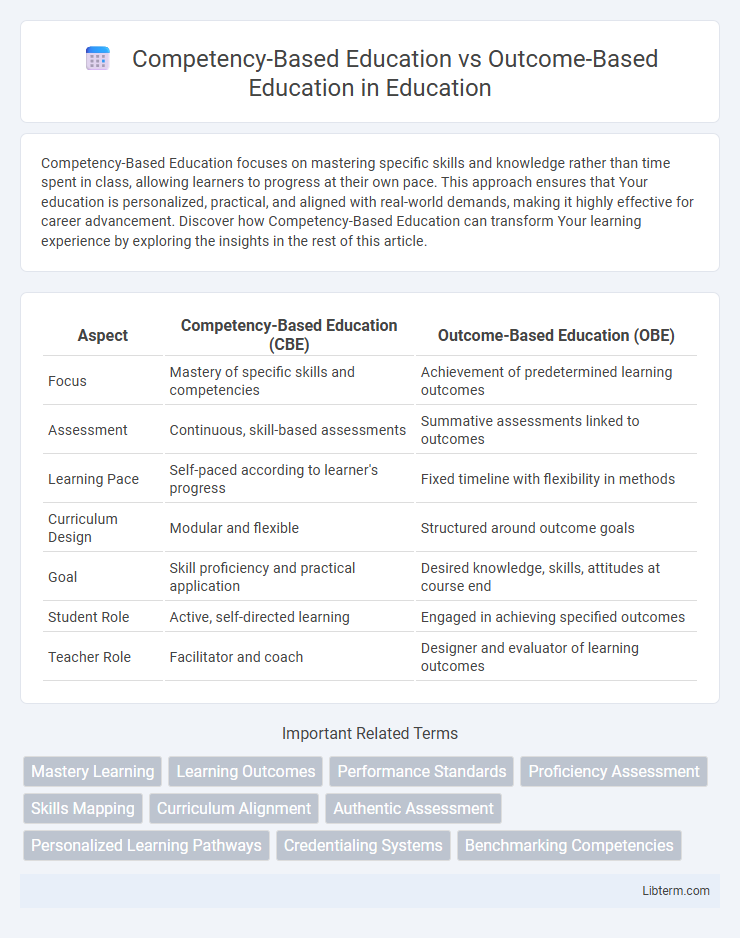Competency-Based Education focuses on mastering specific skills and knowledge rather than time spent in class, allowing learners to progress at their own pace. This approach ensures that Your education is personalized, practical, and aligned with real-world demands, making it highly effective for career advancement. Discover how Competency-Based Education can transform Your learning experience by exploring the insights in the rest of this article.
Table of Comparison
| Aspect | Competency-Based Education (CBE) | Outcome-Based Education (OBE) |
|---|---|---|
| Focus | Mastery of specific skills and competencies | Achievement of predetermined learning outcomes |
| Assessment | Continuous, skill-based assessments | Summative assessments linked to outcomes |
| Learning Pace | Self-paced according to learner's progress | Fixed timeline with flexibility in methods |
| Curriculum Design | Modular and flexible | Structured around outcome goals |
| Goal | Skill proficiency and practical application | Desired knowledge, skills, attitudes at course end |
| Student Role | Active, self-directed learning | Engaged in achieving specified outcomes |
| Teacher Role | Facilitator and coach | Designer and evaluator of learning outcomes |
Introduction to Competency-Based and Outcome-Based Education
Competency-Based Education (CBE) centers on learners demonstrating specific skills and knowledge at their own pace, emphasizing mastery over time spent. Outcome-Based Education (OBE) focuses on clearly defined learning outcomes that all students must achieve by the end of instruction, ensuring measurable performance standards. Both approaches prioritize accountability and student-centered learning, but CBE individualizes progress while OBE aligns curriculum and assessment to predetermined goals.
Defining Competency-Based Education (CBE)
Competency-Based Education (CBE) centers on students mastering specific skills and knowledge at their own pace, emphasizing measurable abilities and practical application. It contrasts with Outcome-Based Education by focusing more on clearly defined competencies rather than broad educational results. CBE frameworks prioritize personalized learning paths, real-world proficiency, and continuous assessment to ensure learners achieve targeted competencies.
Defining Outcome-Based Education (OBE)
Outcome-Based Education (OBE) is an educational approach centered on clearly defining measurable student outcomes, focusing on what learners are expected to demonstrate upon completion of a course or program. It emphasizes aligning curriculum, instruction, and assessment to achieve specific competencies and skills that meet industry or academic standards. OBE ensures accountability by assessing performance against predefined outcomes, promoting continuous improvement in educational effectiveness.
Key Principles of CBE vs OBE
Competency-Based Education (CBE) centers on students mastering specific skills or competencies at their own pace, emphasizing personalized learning paths and real-world application. Outcome-Based Education (OBE) focuses on achieving predefined educational results, ensuring that all learners meet consistent academic standards through structured assessments. Key principles of CBE include individualized pacing, mastery learning, and skill demonstration, while OBE prioritizes clearly defined outcomes, curriculum alignment, and systematic evaluation of student performance.
Curriculum Structure and Design
Competency-Based Education (CBE) emphasizes mastery of specific skills and knowledge through personalized pacing, allowing learners to progress once competencies are demonstrated, resulting in modular, flexible curriculum design. Outcome-Based Education (OBE) focuses on clearly defined learning outcomes that all students must achieve by the end of a course, structuring the curriculum around those target outcomes with standardized assessment timelines. Both models prioritize measurable achievements, but CBE offers adaptive, learner-centered pathways while OBE ensures uniformity in educational goals and assessment criteria.
Assessment Methods in CBE and OBE
Assessment methods in Competency-Based Education (CBE) emphasize demonstration of practical skills and mastery through performance tasks, portfolios, and real-world simulations, ensuring learners achieve specific competencies. Outcome-Based Education (OBE) employs assessments designed to measure whether predefined learning outcomes are met, often using standardized tests, rubrics, and continuous evaluations linked directly to curriculum goals. Both approaches prioritize assessment alignment with learning targets, but CBE focuses more on individual learner progression and skill application, while OBE centers on the achievement of uniform educational outcomes across a cohort.
Role of Teachers and Learners
In Competency-Based Education (CBE), teachers act as facilitators who provide personalized guidance to ensure learners master specific skills at their own pace, while learners take an active role in demonstrating competencies through practical application. Outcome-Based Education (OBE) requires teachers to design curricula aligned with predefined learning outcomes and assess learners' achievement against these standardized goals, positioning students as goal-oriented participants responsible for meeting exact benchmarks. Both approaches emphasize accountability, but CBE centers on individualized progress and mastery, whereas OBE focuses on achieving uniform outcomes across all learners.
Advantages and Challenges of CBE
Competency-Based Education (CBE) offers personalized learning paths that allow students to progress upon demonstrating mastery of specific skills, enhancing flexibility and real-world applicability. It addresses diverse learner needs and promotes lifelong learning, yet challenges include the need for robust assessment systems and potential resource intensiveness in curriculum design. Ensuring consistent quality and scalability remains a significant hurdle for institutions adopting CBE frameworks.
Advantages and Challenges of OBE
Outcome-Based Education (OBE) emphasizes measurable results and clear learning outcomes, enabling institutions to align curriculum, instruction, and assessment with specific competencies required for real-world application, which enhances accountability and transparency in education. One advantage of OBE is its focus on student mastery and personalized learning paths, allowing educators to identify and address individual learning gaps effectively. Challenges include the complexity of designing valid and reliable assessments for diverse outcomes and the risk of reducing education to a checklist of skills rather than fostering deeper critical thinking and creativity.
Choosing Between CBE and OBE: Factors to Consider
Choosing between Competency-Based Education (CBE) and Outcome-Based Education (OBE) requires evaluating factors such as curriculum flexibility, student assessment methods, and industry relevance. CBE emphasizes mastering specific skills and knowledge at an individualized pace, making it ideal for technical and vocational programs. OBE focuses on achieving predefined learning outcomes across broader educational goals, often suited for traditional academic settings and standardized assessments.
Competency-Based Education Infographic

 libterm.com
libterm.com